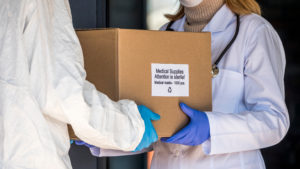What Do Global Supply Chain Shortages on Medical Supplies Mean for Practices?
Consumer price index of medical care services in September rose from last year, despite a decline in prices for medical care commodities.
What Do We Know About Global Supply Chain Inflation?
According to the Bureau of Labor Statistics, food and shelter alone contributed to over half of the 5.4% index increase for all US urban  consumer items. Oil and gas prices are at an all time high, rising to over 42% year over year. This sharp increase in energy has driven up the cost of both new and used vehicles to the highest Americans have seen since 1980. Additionally, we are noticing increases in other commodities such as food, alcoholic beverages, apparel, and tobacco goods. Despite what seems to be universal price increases, even for medical care services, the cost of medical care commodities has declined by 1.6%.
consumer items. Oil and gas prices are at an all time high, rising to over 42% year over year. This sharp increase in energy has driven up the cost of both new and used vehicles to the highest Americans have seen since 1980. Additionally, we are noticing increases in other commodities such as food, alcoholic beverages, apparel, and tobacco goods. Despite what seems to be universal price increases, even for medical care services, the cost of medical care commodities has declined by 1.6%.
How Will Medical Supplies be Affected by Rising Costs?
Healthcare providers are wondering how rising costs will affect their practice. The Bureau’s October Economic News Release sheds light on possible global supply chain inflations on medical supplies. By and large, medical care prices have remained unchanged in September, even with a decrease in prescription drug prices. Compared to last year, however, overall medical care prices are still growing. You may have experienced moderate price increases firsthand with certain consumables such as gloves and face masks.
We may expect to see rising prescription drug prices again soon if this trend continues.
Altarum, a nonprofit organization that conducts private research and advisory services, releases monthly reports that reveal price changes for major components of health care expenditures. In their recent October 2021 Health Sector Economic Indicators Price Briefs, the overall Health Care Price Index has increased slightly by 2.0% in September since last year. Although prices of durable medical equipment and nondurable medical products have fallen, the cost of physician and clinical services have nearly tripled. Altarum notes that “we may expect to see rising prescription drug prices again soon if this trend continues.”
How Can You Prepare for Medical Supply Chain Shortages?
 As of October 20, 2021, more than half a million containers are stranded in the ports of California with no immediate plans to bring their goods into the docks. This represents billions of dollars in the US supply chain, and also it’s not only money. Experts warn this supply chain crisis could last until 2023, and global shortages of goods will continue driving up prices and causing stock outs on everything from apparel to furniture to medical supplies and devices.
As of October 20, 2021, more than half a million containers are stranded in the ports of California with no immediate plans to bring their goods into the docks. This represents billions of dollars in the US supply chain, and also it’s not only money. Experts warn this supply chain crisis could last until 2023, and global shortages of goods will continue driving up prices and causing stock outs on everything from apparel to furniture to medical supplies and devices.
While you may not need to hoard excess inventory of PPE and lidocaine yet, it is imperative to anticipate increases in medical supply and device costs and considerably longer lead times to get them. This is largely due to global constraints in labor and shortages of raw materials such as plastics, metals, glass, and electronics that will have an impact on supplier inventory and distribution. The implication of rising oil and gas prices means that the cost to ship medical supplies and equipment from overseas will be greater. It won’t be long before these costs trickle down to you, the consumer.
A good rule of thumb is to ensure that your medical spa has enough supplies to last you at least 3 months.
A good rule of thumb is to ensure that your medical spa has enough supplies to last you at least 3 months. This will enable you to stay ahead of inflation trends, supply shortages, and consumer demand for aesthetic treatments.
If you are in need of practice essentials, the Aesthetic Record Marketplace provides hundreds of high quality consumables, furnishings, prescription drugs and more at low prices. Register for your FREE lifetime membership today at market.aestehticrecord.com.





